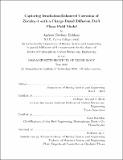| dc.contributor.advisor | Michael P. Short. | en_US |
| dc.contributor.author | Dykhuis, Andrew Frederic | en_US |
| dc.contributor.other | Massachusetts Institute of Technology. Department of Nuclear Science and Engineering. | en_US |
| dc.date.accessioned | 2018-11-15T15:51:41Z | |
| dc.date.available | 2018-11-15T15:51:41Z | |
| dc.date.copyright | 2018 | en_US |
| dc.date.issued | 2018 | en_US |
| dc.identifier.uri | http://hdl.handle.net/1721.1/119029 | |
| dc.description | Thesis: Ph. D., Massachusetts Institute of Technology, Department of Nuclear Science and Engineering, 2018. | en_US |
| dc.description | This electronic version was submitted by the student author. The certified thesis is available in the Institute Archives and Special Collections. | en_US |
| dc.description | Cataloged from student-submitted PDF version of thesis. | en_US |
| dc.description | Includes bibliographical references (pages 389-400). | en_US |
| dc.description.abstract | Zircaloy-4 has been used in pressurized water reactors (PWRs) for decades, and enhanced corrosion rates in reactors compared to out-of-pile have long been observed. However, the exact mechanism explaining the early departure from autoclave kinetics after 3-5 microns of oxide have formed has proved elusive. This thesis considers and evaluates a number of possible explanations for this early acceleration in kinetics. The bulk of the evidence points to Fe depletion from secondary phase particles (SPPs) as the culprit in enhancing Zircaloy-4 corrosion rates in PWRs. These new findings have been incorporated in a mechanistic finite-element phase field model of Zircaloy-4 corrosion called HOGNOSE. It accounts for both diffusion-and drift-based oxygen anion transport in Zircaloy-4 by including the effects of radiation-induced evolution of SPPs in changing the contribution of a local charge transport inequality through their depletion and release of iron. By addressing the imbalance in charged particle transport, the code can be adapted to model multiple zirconium-based alloys in autoclave and irradiated conditions with minimal parameter fitting. Rather than the typical empirical approach, HOGNOSE uses a physics-based methodology to capture the early agreement between autoclave and in-reactor data and the point at which reactor kinetics are enhanced compared to autoclave kinetics. HOGNOSE results agree fairly well with those observed in experiments for oxide thicknesses less than 10 microns, above which other enhancement mechanisms can no longer be safely ignored. HOGNOSE captures increasing amorphization with decreasing temperature, and more subtle corrosion rate enhancement at higher temperatures. Comparisons between HOGNOSE results and literature data suggest that the next focus for mechanistic modeling should consider additional neutron flux effects. To support HOGNOSE development, corrosion testing of Zircaloy-4 in steam at atmospheric pressure and 415 degrees Celsius was performed. Samples were analyzed using a focused ion beam/scanning electron microscope (FIB/SEM) to obtain oxide thickness measurements with greater temporal resolution than is widely provided by autoclave testing. Oxide thickness data was used to determine the thermal dependence of oxygen diffusivity in the oxide within HOGNOSE. HOGNOSE would also benefit from measurements of the concentrations and charge states of cation dopants in post-irradiated Zircaloy oxides to help determine whether this model is truly accurate in its physical description. | en_US |
| dc.description.statementofresponsibility | by Andrew Frederic Dykhuis. | en_US |
| dc.format.extent | 400 pages | en_US |
| dc.language.iso | eng | en_US |
| dc.publisher | Massachusetts Institute of Technology | en_US |
| dc.rights | MIT theses are protected by copyright. They may be viewed, downloaded, or printed from this source but further reproduction or distribution in any format is prohibited without written permission. | en_US |
| dc.rights.uri | http://dspace.mit.edu/handle/1721.1/7582 | en_US |
| dc.subject | Nuclear Science and Engineering. | en_US |
| dc.title | Capturing irradiation-enhanced corrosion of zircaloy-4 with a charge-based diffusion/drift phase field model | en_US |
| dc.type | Thesis | en_US |
| dc.description.degree | Ph. D. | en_US |
| dc.contributor.department | Massachusetts Institute of Technology. Department of Nuclear Science and Engineering | |
| dc.identifier.oclc | 1059464550 | en_US |
